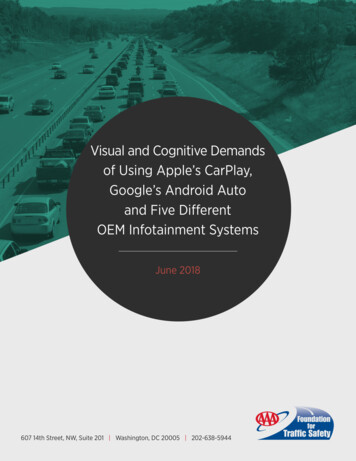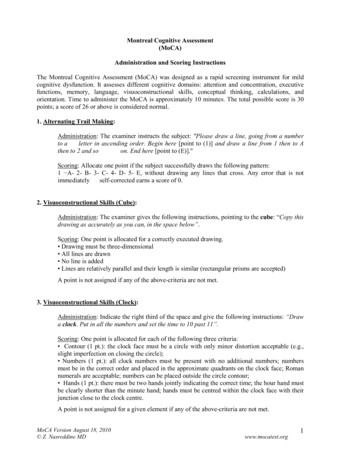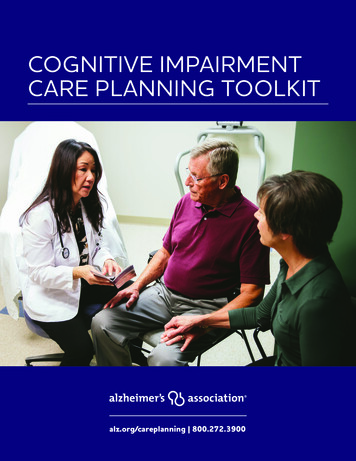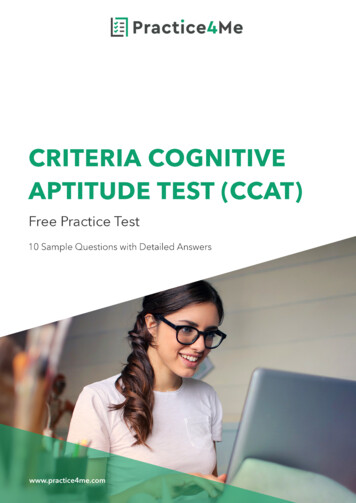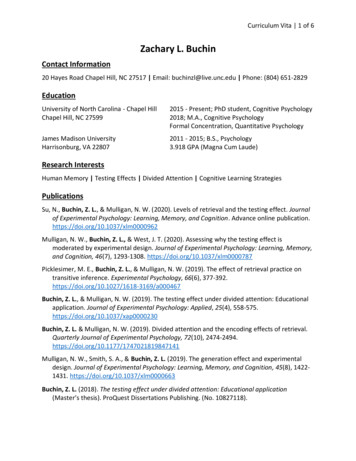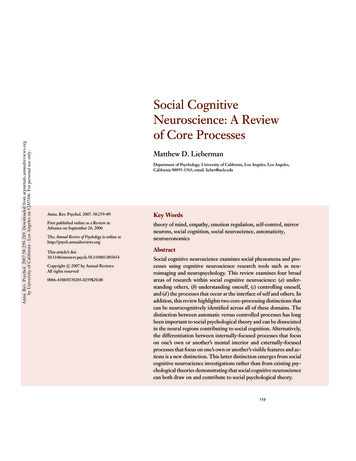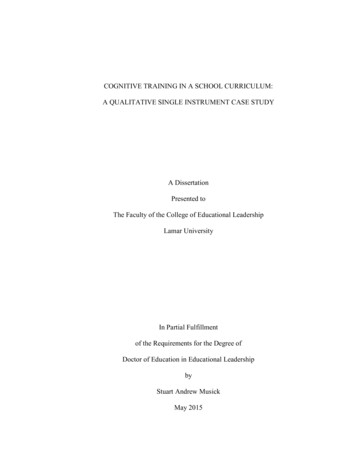
Transcription
COGNITIVE TRAINING IN A SCHOOL CURRICULUM:A QUALITATIVE SINGLE INSTRUMENT CASE STUDYA DissertationPresented toThe Faculty of the College of Educational LeadershipLamar UniversityIn Partial Fulfillmentof the Requirements for the Degree ofDoctor of Education in Educational LeadershipbyStuart Andrew MusickMay 2015
ProQuest Number: 3721288All rights reservedINFORMATION TO ALL USERSThe quality of this reproduction is dependent upon the quality of the copy submitted.In the unlikely event that the author did not send a complete manuscriptand there are missing pages, these will be noted. Also, if material had to be removed,a note will indicate the deletion.ProQuest 3721288Published by ProQuest LLC (2015). Copyright of the Dissertation is held by the Author.All rights reserved.This work is protected against unauthorized copying under Title 17, United States CodeMicroform Edition ProQuest LLC.ProQuest LLC.789 East Eisenhower ParkwayP.O. Box 1346Ann Arbor, MI 48106 - 1346
COGNITIVE TRAINING IN A SCHOOL CURRICULUM:A QUALITATIVE SINGLE INSTRUMENT CASE STUDYSTUART ANDREW MUSICKApproved:Jason R. MixonDissertation ChairDiane D. MasonCommittee MemberKathryn JonesCommittee MemberJason R. MixonDirector, Doctoral ProgramJason R. MixonChair, Department of Educational LeadershipWilliam HolmesInterim Dean, College of Education and Human DevelopmentWilliam E. HarnDean, College of Graduate Studies
2015 by Stuart Andrew MusickNo part of this work may be reproduced without permission except as indicated by the“Fair Use” clause of the copyright law. Passages, images, or ideas taken from this workmust be properly credited in any written or published materials.
ABSTRACTCOGNITIVE TRAINING IN A SCHOOL CURRICULUM:A QUALITATIVE SINGLE INSTRUMENT CASE STUDYbyStuart Andrew MusickThis qualitative case study examined practical, effective applications of implementing acognitive training curriculum into a high school curriculum. The intent was to helpstudents increase student achievement by targeting areas of learning deficiency,assertively focusing on intensive remediation, and ultimately decreasing or removingthose areas of weakness in the learning altogether. This study investigated how cognitivetraining can help both regular education students and students with disabilities. Thenotion of training or re-training the brain to think faster, more efficiently, and at higherlevels was the focus of this research and the experiments that were discussed. Thepurpose of this qualitative case study was to examine practical, effective applications ofimplementing a cognitive training curriculum into a school with the intent of helping allstudents be successful. A cognitive training program was defined as any program thatattempts to help a student learn faster, easier, and better (Hill, 2012).
ACKNOWLEDGEMENTSFirst, I am both grateful for and thankful to the numerous fellow educators thathave mentored me along my career as a teacher, coach, and administrator. You havehelped me to learn from both the positive experiences and mistakes that I have made onthis 24 year journey. Thank you for helping me to be a better teacher each and every day.Secondly, I am grateful for the peers that traveled this journey with me as wehelped and supported one another in Lamar’s Online Cohort 3 (OC3). Your input andviewpoints through both discussions and collaboration were invaluable.Next, I am thankful to Dr. Jason Mixon. Even though he didn’t know it, he wasmy first professor in my first administrative Principal Preparation Program class fromStephen F. Austin State University. He helped to inspire me to become a better teacherand transition from 17 years as a teacher/coach and prepare to become an administratorthat strived to do what is best for students and staff. Later, he is the person thatchallenged me to begin and complete this Doctoral process and allow it to be more than acareer changer, but a life changer.To my parents, Mack and Helen Musick, thank you not only for your supportalong this path, but for your endless support throughout my life to help make me theperson that I am. I could not have asked for two more perfect role models or two moreperfect and loving parents.To my family, thank you for your support, encouragement, and patience to helpthis dream come true. Thank you to Emma and Brennan for allowing “Daddy” to reachfor this goal. Most of all, thank you to my beautiful wife, Lauren, for your countlessiii
sacrifices, positive support, and encouragement to help me be the man, the husband, andthe father that I want to be.Finally, thank you to our Father in Heaven, for Your love, patience, blessings,provision, and ultimate sacrifice for our lives. Without You, nothing is possible. WithYou, all things are possible.iv
Table of ContentsList of TablesxList of FiguresxiChapterPageI1IIIntroduction to the StudyBackground2Problem Statement5Theoretical Considerations5Purpose Statement7Research Questions8Rationale and Significance of the itions11Summary12Review of the Literature13Theoretical Considerations14Neuroplasticity15Areas of Cognitive Development15Training Working Memory16Visual Processing Levels17Auditory Processing Levels18v
Growing Your Intelligence18Pre-Frontal Activity19Parietal Activity19Fluid Intelligence20Temporal Dynamics21Spatial Dynamics21Relationships Between Reasoning and ComprehensionInductive Reasoning23Deductive Reasoning24Changes In Student Levels of Success25Case Studies27Students with Attention Deficit Hyperactivity Disorder27Stroke Victims28Poor Readers29Age Differences30Cognitive Training in the ClassroomNational Science Foundation StudyIII223233Summary43Methodology44Purpose of the Study45Research Questions45Research Design45Participants and Setting46vi
IVData Collection48Data Collection Procedures49Treatment of the Data49Provisions of Trustworthiness50Epoche50Summary51Analysis of the Data52Presenting the Findings53National Science Foundation Research Project Findings54Teacher Interviews56Teacher A57Teacher B58Teacher C59Teacher D60Teacher E61Themes From Teacher Interviews63Student Interviews64Student A64Student B65Student C66Student D67Student E67Student F68vii
Student G69Themes From Student Interviews70Trainer Interviews72Trainer 172Trainer 274Trainer 375Facilitator76Themes From Trainer Interviews81Researcher Interviews83Themes From Researcher InterviewsSummaryV8687Summary, Conclusions, Implications, and RecommendationsSummary of the Study8888Brief Overview of the Problem89Purpose Statement90Research Questions90Review of the Study Design90Summary of Major Findings92Conclusions93Implications for Practice95Recommendations for Future Research96Concluding Remarks97References98viii
List of Appendices105Appendix ANational Science Foundation Letter of Invitation106Appendix BNational Science Foundation Letter of Results108Appendix CNational Science Foundation FERPA Letter110Appendix DNational Science Foundation Letter of Conclusion112Appendix EGrading and Expectations113Appendix FTeacher Surveys114Appendix GParent Surveys117Appendix HIRB Consent Form for Interview118Appendix IGuided Protocol120Appendix JIRB Approval121Appendix KCertificate of Human Subject Research Training122Appendix LLetter of Permission –Waskom Independent School District123Appendix M Letter of Permission –Virginia State UniversityBiographical Note124125ix
List of TablesTablePageTable 1Student Table54Table 2Summary of Findings56Table 3Daily Class Period Record77Table 4Daily High Scores78Table 5Waskom High School Totals79x
List of FiguresFigurePageFigure 1Brain Training Mind Map3Figure 2Example of Waskom High School Graph34xi
Musick 1Chapter IIntroduction to the StudyIn a qualitative single instrumental case study (Stake, 1955), the researcherfocuses on an issue or concern, and then selects one bounded case to illustrate that issue(Creswell, 2013). In this qualitative single instrumental case study, the researcherfocused on the issue of how to improve student achievement in a public school setting.The study examined not only how we learn, but how to increase our capacity to learneffectively. This topic reached across a global community of learners. It was an area ofinterest that is not limited by national origin, race, or culture, but can be beneficial toanyone that desires to improve learning.The study examined practical, effective applications of implementing a cognitivetraining curriculum into a high school curriculum. The intent was to help studentsincrease student achievement by targeting areas of learning deficiency, assertivelyfocusing on intensive remediation, and ultimately decreasing or removing those areas ofweakness in the learning altogether. This chapter of the study was organized bybackground, problem statement, theoretical considerations, purpose statement, researchquestions, rationale for the study, assumptions, limitations, delimitations, key terms, andthe summary of the chapter.In a time where school districts are held to higher accountability standards thanever before, many districts may be interested in investing monies toward a program orprograms that will effectively increase their student success in the classroom and onstandardized tests (Texas Education Agency, 2011). However, it is also important to notethat those same school districts and systems are being required to stretch their budget
Musick 2further than ever before and do more with less funding (Stutz, 2013). This study will beconducted using a qualitative design methodology to gather data on the use of braintraining with all high school students in grades 9-12 at a small 3-A rural school districtlocated in East Texas.BackgroundA key target of cognitive training research is how it can help learners learn moreeffectively (Hill, 2012). The notion of training or re-training the brain to think faster,more efficiently, and at higher levels is the focus of this research and the experiments thatwill be discussed.The Cognitive training industry is a multi-million dollar industry (Sparks, 2012).Cognitive training, including training working memory, has been influenced by theincreasing number of researchers and studies in the field of neuroplasticity. Sparks(2012) cited the San Francisco based market research SharpBrains to indicate thatbetween 2005 and 2009, the cognitive training industry increased 31 percent to 295million dollars. SharpBrains stated that just over half of the money spent during that timeframe, 148 million dollars, came from the United States.Figure 1 below illustrates a mind map exercise that included just some of thedifferent areas of brainstorming when considering all of the endless directions thatcognitive training could be considered.
Musick 3Figure 1. Brain Training Mind Map.Whether you are an adolescent, a young adult, middle aged, or elderly, there areways that you can keep the brain active and improve your brain’s health (Willment,2014). The author stated that individuals are encouraged to not only exercise for theirphysical health, but for their mental health, as well. As people engage in physicalactivities to increase cardiovascular health and improve muscle strength, they are alsoencouraged to do mental and cognitive activities that exercise the brain (Aamodt &Wang, 2007). People are also asked to choose not only mental activities, such as tricks tohelp remember people’s names or lists, but also to select computerized activities thatstimulate the brain to think and practice (Willment, 2014).
Musick 4In Willment’s (2014) article, she stated that such exercises can even have beneficialeffects that last up to ten years. Willment (2014) went further and stated that smallactivities such as reading and crossword puzzles can even have a beneficial effect. Sherecommended increasing your concentration and attention levels by using programs thatuse computerized training and teach strategy skills.The Center for Brain Health lists brain research and cognitive training being usedin studies in a wide range of fields including addictions, Alzheimer’s disease in olderadults, Attention Deficit Hyper Activity Disorder (ADHD), Autism, Mild CognitiveImpairments (MCI), brain injuries, as well as military personnel and Post TraumaticStress Disorder (PTSD) (Klingberg et al., 2004). Cognitive training exercises are alsobeing used in athletes for both performance improvements and in the area of concussionsand how they affect the brain (Ulfarsson, 2014).In our schools, money is spent each year in the areas of remediating students thatare behind their peers in subjects including math, science, and reading (Stutz, 2013).There are many ways that schools may go about narrowing those learning gaps includingtutorials, software programs, additional staff for smaller student-teacher ratios, andassessments to determine what areas the student may be lacking (Rode et al., 2014).Hiring a tutor may help when a student did not understand a concept when it was taughtthe first time. This may be caused by distractions or other interfering factors to thelearning or even the teaching (Heron, 2010). If a student continues to struggle withlearning, there may be a need for cognitive training to identify and target the needed areaof learning difficulty (D. Walker, personal communication, September, 2014).
Musick 5Problem StatementWhether you are a classroom teacher or a coach, both look for ways to increasestudent, or student-athlete, success. The same is true as an administrator. No matterwhat the role or what the title may be, educators seek the most effective strategy toincrease learning (Stutz, 2013). There are numerous companies or organizations thatclaim that their software or their packages are the way to go (Bryan, 2014). The concernfor the public school administrator with little or no money to spend in additional areas ishow they can get the most bang for their buck to help their students succeed (Rode et al.,2014).In a time where school districts have decreased revenue and funding from thestate, many districts have decreased staffing which leads to larger classes (Stutz, 2013).The question then becomes how we can effectively and efficiently utilize our programsand our personnel to maximize student success. The cognitive training industry is amulti-million dollar industry (Aamodt & Wang, 2007) that is focused on their profits.That conflicts with the goal of schools that are focused on cutting costs while stillmaintaining student success (Stutz, 2013).Theoretical ConsiderationsStarting in the early 1960’s, Dr. Paul MacLean introduced the concept that we donot just have one brain, but three. The Triune Brain Theory holds to the concept that thebrain acts as three separate areas that include the Reptile Brain responsible for basedrives, the Mid Brain that is essentially responsible for emotions and memory, and theNeocortex responsible for higher levels of brain functions (MacLean, 1990). While theTriune Brain is still used as a model for research, most modern neuroscientists have
Musick 6moved past the original thought of the brain as three separate brains and consider thatthought as outdated (Reardon, 1999). Today, developmental biologists look to the brainas much more complex, even in the most simple of animals (Deutsche, 2003).In an article published in July, 2014, researchers at the University of Montrealdiscussed targeting specific brain exercises to bring about specific, desired results(Belleville, 2014). Belleville (2014) stated:Our work shows that there is also an association between the type of cognitivetraining performed and the resulting effect. This is true for healthy seniors whowant to improve their attention or memory and is particularly important forpatients who suffer from damage in specific areas of the brain. We therefore needto better understand the ways to activate certain areas of the brain and target thisaction to get specific results. (p. 8)Part of the research highlights the effects of cognitive training exercises and how it mayhelp with multi-tasking. The researches state that the ability to effectively multi-taskdecreases with age, but this decline may be slowed, or even reversed, with cognitiveexercises (Belleville, 2014).Recently, results from an 11 year study on brain injury were produced that showthe follow up data from individuals that received cognitive training therapy to treat thebrain injuries they had incurred (Ulfarsson, 2014). The research showed that thetreatment results were directly and positively related to how quickly the individualreceived the cognitive training regiments during their recovery (Ulfarsson, 2014).Ulfarsson (2014) also stated that the patient’s chances of survival were also directly andpositively affected by the cognitive training. According to the results of the study,
Musick 7Ulfarsson (2014) believes that immediate cognitive training could increase long-termsurvival. However, he also stated that deciding factors for recovery included admissionto rehabilitation support at the right time, special interventions for patients who wereunemployed or on sick leave prior to the injury, and assessment of pituitary function inoverweight patients (Ulfarsson, 2014).In her recent study, Dr. Lori Bryan (2014) stated:In less than 20 years, an underlying tenet in neuroscience that the brain does notchange beyond early childhood has undergone a radical shift. It has beendemonstrated that not only can the brain change, but it is capable of doing sothroughout the life span. (p. 2)She goes on to explain that cognitive training can have positive effects on the attentionspan, working memory, visual and auditory processing speeds, logic, and reasoning(Bryan, 2014). She concluded by saying that a biological basis supporting quality,effective cognitive training programs is supported by the discovery that physical changesin the brain can and do occur across a person’s lifespan (Bryan, 2014). She also statedthat areas of cognitive skills that were weaker could be strengthened with the appropriatecognitive training including measureable improvements in intellectual ability (Bryan,2014). This theoretical statement was the framework for this study.Purpose StatementThe purpose of this qualitative case study was to examine practical, effectiveapplications of implementing a cognitive training curriculum into a school with the intentof helping all students be successful. By using cognitive training programs in theclassroom, the intent of helping high school students increase student achievement may
Musick 8be realized by targeting areas of learning deficiency, assertively focusing on intensiveremediation, and ultimately decreasing or removing those areas of weakness in thelearning altogether.A cognitive training program was defined as any program that attempts to help astudent learn faster, easier, and better (Hill, 2012). The research focused on targetingareas of learning deficiency, assertively focusing on intensive remediation, and ultimatelydecreasing or removing those areas of weakness in the learning altogether.Research QuestionsThe following research questions guided this study:1. What components of one-on-one personal cognitive training are perceived aspractical and effective?2. What components of online computerized cognitive training are perceived aspractical and effective?3. How can cognitive training be implemented in the curriculum to help enableteachers to affect learning outcomes and improve student performance?Rationale and Significance of the StudyThere is still much debate that needs to be researched to challenge whether or notcognitive training actually works (Sparks, 2012). Sparks (2012) stated that moreimportantly, it is crucial to challenge specific companies and cognitive training activitiesto see which ones actually do work and are worth the money spent on them. In a timewhere school districts are held to higher accountab
Lamar University In Partial Fulfillment . A cognitive training program was defined as any program that attempts to help a student learn faster, easier, and better (Hill, 2012). . challenged me to begin and complete this Doctoral process and allow
